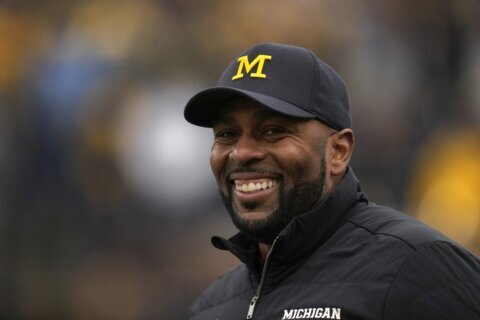From its first snap of the season, Michigan State showed that coach Mel Tucker’s rebuilding project wouldn’t take nearly as long as expected.
Wake Forest transfer Kenneth Walker took a handoff, made a move around a defender and raced down the left sideline for a 75-yard touchdown against Northwestern.
Walker and Co. have shown how the relaxed NCAA guidelines allowing players to transfer without sitting out a season can make it easier to revitalize slumping programs.
“I knew coach (Tucker) had a plan, and I believed in his plan,” said Walker, who added that he wrote down his goal of winning the Heisman Trophy back in March.
Walker has rushed for 680 yards to lead all Football Bowl Subdivision players and help the 11th-ranked Spartans win their first five games, a dramatic rise from their 2-5 finish last year in the pandemic-delayed debut season for Tucker.
He isn’t the only transfer making a difference for the Spartans. And Michigan State isn’t the sole unbeaten Big Ten team to bounce back from a losing season while getting big contributions from players who began their college careers elsewhere.
The impact of the new transfer policy just happens to be most apparent in East Lansing. Michigan State is off to its fastest start since 2015, when it won its first eight games and reached the College Football Playoff.
Tucker overhauled his team during the offseason by adding 20 transfers, with 14 of them coming from other Power Five schools. He said before the season that his roster was stronger and more competitive and it would lead to better football.
The Spartans’ defense features three starters who were playing for Southeastern Conference schools last season in linebacker Quavaris Crouch (Tennessee) and cornerbacks Chester Kimbrough (Florida) and Ronald Williams (Alabama).
No. 4 Penn State also has benefited from transfers while winning its first five games after going 4-5 a year ago.
Former Temple defensive end Arnold Ebiketie leads the Nittany Lions with three sacks. Other transfers playing major roles for Penn State include defensive tackle Derrick Tangelo (Duke), running back John Lovett (Baylor) and guard Eric Wilson (Harvard).
“I felt like leaving Duke would give me more exposure,” Tangelo said. “I just felt like I needed a fresh start.”
No. 9 Michigan has turned things around after going 2-4 last year thanks in part to former Jackson State receiver Daylen Baldwin, who has touchdown catches of 56 and 69 yards.
It’s not uncommon for a Big Ten contender to benefit from transfers. Just last year, Ohio State won its fourth straight conference title and advanced to the national championship game with an backfield featuring former Georgia quarterback Justin Fields and ex-Oklahoma running back Trey Sermon.
Fields needed a waiver to play for Ohio State without sitting out a season, and Sermon could play immediately for the Buckeyes only because he was a graduate transfer. Those steps are no longer necessary now that the NCAA has ruled all athletes can transfer once without having to wait a year to play for their new teams.
“Everybody gets a hall pass,” Iowa coach Kirk Ferentz said. “Some people were getting them anyway before. Now everybody’s got one. At least they get one mulligan card in their pocket. We’ve played against a lot of transfers over the last four or five weeks, and we’ll see more this year.”
The policy change makes it much more tempting for schools to dip into the transfer portal when they need to restock their rosters.
Big Ten network analyst and former Indiana coach Gerry DiNardo could see the trend continuing, with teams making sure someone on their support staff has the specific role of viewing video to see which potential transfers could be ideal fits.
“There’s no rule against having as big a back room as you want,” said DiNardo, who also coached LSU and Vanderbilt. “As long as the athletic directors are willing to give coaches unlimited resources when it comes to personnel, this is going to keep going.”
The impact of transfers was evident from the first game of the season, when former North Carolina State linebacker Calvin Hart and former Rutgers quarterback Artur Sitkowski played key roles in Illinois’ victory over Nebraska.
That set the tone for the rest of the season. The Big Ten is getting plenty of big performances from guys who were playing at other programs just last year.
Indiana’s Stephen Carr (Southern California) and Wisconsin’s Chez Mellusi (Clemson) are the top rushers for their respective teams. Nebraska’s Samori Toure (Montana) and Minnesota’s Dylan Wright (Texas A&M) lead their teams in yards receiving.
Minnesota linebacker Jack Gibbens (Abilene Christian) is the Gophers’ most prolific tackler. Purdue’s Jamari Brown, a cornerback for Kentucky last season, is tied for the team lead in pass breakups.
Of course, these new transfer policies can work both ways.
The Southeastern Conference’s third-leading receiver is Kentucky’s Wan’Dale Robinson, who played for Nebraska last year. Indiana has lost two backup running backs to the transfer portal since August. Michigan State had three players enter the transfer portal less than two weeks ago.
But that’s a tradeoff Big Ten programs are willing to make. They only need to look at the league standings to understand how this era of widespread transfers can benefit them.
___
AP sports writers Dave Campbell, Tom Canavan, Larry Lage, Michael Marot and Eric Olson and AP freelance writers John Bohnenkamp and Travis Johnson contributed to this report.
___
More AP college football: https://apnews.com/Collegefootball and https://twitter.com/AP_Top25
Copyright © 2024 The Associated Press. All rights reserved. This material may not be published, broadcast, written or redistributed.






